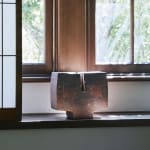Suzuki Osamu (1926−2001)
Clay Mask: Two Faces
Stoneware
Marked “Su” on the side
With a box signed by the artist
D17.9 x W27.9 x H23.5 cm
Marked “Su” on the side
With a box signed by the artist
D17.9 x W27.9 x H23.5 cm
Further images
Suzuki Osamu’s “Clay Mask” series followed his series of “Clay Figures,” works that are often subsumed under the category of “kiln-fired objet” (obuje-yaki). Suzuki was wary of that expression; in fact, he preferred more specific appellations. Notably, the artist used the character dei for the original Japanese title of his “Clay Figures”, which carries a nuance of “mud,” and the character do for the “Clay Mask” series, which depending on context may also read as “earth” or “soil.” This work, a cuboid form suggesting two human faces on its opposing sides, shows two characteristics: First, it is a high-fired unglazed work with a distinctive reddish-brown tint common to much of Suzuki’s output, and secondly, the artist relinquishes the potter’s wheel in favor of an angular, geometrical approach. Indeed, Suzuki pushes for maximum simplicity in terms of color and shape. Interestingly, there are traces that might be the artist’s fingerprints left visible on the surface of the work.
Suzuki proceeded from the “Clay Figures” of 1965, with their strong sense of volume, to works such as the present one after developing various new ideas around 1967. The parallels between Clay Mask: Two Faces and, for instance, Child Statue of the Kodama Museum of Art in Kagoshima, include the slight bulge on the sides, the use of a different red tone to suggest the face’s eyes on the front and rear, and the deep cut in the center, here perhaps representing a nose. Fittingly, the artist has stated that he considered his works not as “abstract” but “symbolic.” The different reddish shades are employed to structure the surface as a further means to add to the expressive quality of the object. An almost identical work in the collection of the Kitamura Museum is dated 1967; the artist submitted it for the Premio Faenza (International Competition of Ceramic Art) in 1971. This work, also title Clay Mask, is slightly smaller than the present one.
Clay Mask rejected two important aspects of traditional ceramic making: the notion of the (functional) vessel and reliance on the potter’s wheel. Suzuki, the son of the potter’s wheel worker Suzuki Ugenji, later admitted that it took him a long time to free himself of his dependence on the ubiquitous tool.
In 1969, Suzuki began to experiment with celadon porcelain, saying that “clay is for shaping form, and stone [= porcelain] is for adding form.” That considered, it is likely that Clay Mask: Two Faces dates to 1967, when Suzuki concentrated on “shaping form” from clay.
Suzuki Osamu (Ceramist; 1926−2001)
Suzuki was born in Kyoto to a family of ceramists. With like-minded artists Yagi Kazuo and Yamada Hikaru, he co-founded the avant-garde ceramic group Sodei-sha (Crawling through Mud Association) in 1948. Suzuki challenged the utilitarian attitude of traditional ceramics with his non-functional objects which he termed deizo or deisho (“clay figures” or “clay forms”). He served as a professor at the Kyoto City University of the Arts and was honored with the Asahi Award of Excellence in 1999.
Suzuki proceeded from the “Clay Figures” of 1965, with their strong sense of volume, to works such as the present one after developing various new ideas around 1967. The parallels between Clay Mask: Two Faces and, for instance, Child Statue of the Kodama Museum of Art in Kagoshima, include the slight bulge on the sides, the use of a different red tone to suggest the face’s eyes on the front and rear, and the deep cut in the center, here perhaps representing a nose. Fittingly, the artist has stated that he considered his works not as “abstract” but “symbolic.” The different reddish shades are employed to structure the surface as a further means to add to the expressive quality of the object. An almost identical work in the collection of the Kitamura Museum is dated 1967; the artist submitted it for the Premio Faenza (International Competition of Ceramic Art) in 1971. This work, also title Clay Mask, is slightly smaller than the present one.
Clay Mask rejected two important aspects of traditional ceramic making: the notion of the (functional) vessel and reliance on the potter’s wheel. Suzuki, the son of the potter’s wheel worker Suzuki Ugenji, later admitted that it took him a long time to free himself of his dependence on the ubiquitous tool.
In 1969, Suzuki began to experiment with celadon porcelain, saying that “clay is for shaping form, and stone [= porcelain] is for adding form.” That considered, it is likely that Clay Mask: Two Faces dates to 1967, when Suzuki concentrated on “shaping form” from clay.
Suzuki Osamu (Ceramist; 1926−2001)
Suzuki was born in Kyoto to a family of ceramists. With like-minded artists Yagi Kazuo and Yamada Hikaru, he co-founded the avant-garde ceramic group Sodei-sha (Crawling through Mud Association) in 1948. Suzuki challenged the utilitarian attitude of traditional ceramics with his non-functional objects which he termed deizo or deisho (“clay figures” or “clay forms”). He served as a professor at the Kyoto City University of the Arts and was honored with the Asahi Award of Excellence in 1999.





